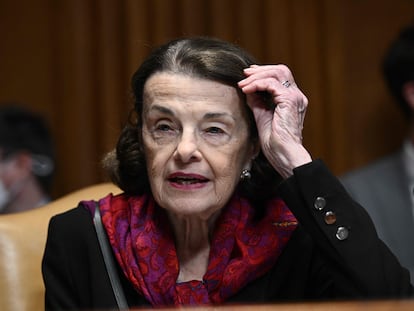Why Senator Feinstein’s absence is a big problem for Democrats
She’s a member of the Senate Judiciary Committee and her vote is critical if majority Democrats want to confirm President Joe Biden’s nominees to the federal courts

Senator Dianne Feinstein’s months-long absence from the Senate to recover in California from shingles has become a vexing problem for Democrats who want to confirm President Joe Biden’s nominees to the federal courts. Now there is some pressure from within her party, and her state, to resign.
With frustration mounting among Democrats, Feinstein on Wednesday asked to be temporarily replaced on the Senate Judiciary Committee while she recuperates. The statement came shortly after a member of California’s House delegation, Democratic Rep. Ro Khanna, called on her to step down, saying it is “unacceptable” for her to miss votes to confirm judges who could be weighing in on abortion rights, a key Democratic priority.
It will not be easy to temporarily replace Feinstein on the influential committee. Republicans could block such a move, given that the full Senate must approve committee assignments.
The conundrum for Senate Majority Leader Chuck Schumer, D-N.Y., stems from his party’s fragile hold on power. Democrats are clinging to a 51-49 majority in an aging Senate where there have been several absences due to health issues this year.
A look at the politics surrounding Feinstein’s absence, and how Democrats are navigating the situation:
Extended absence
Feinstein, 89, has been away from the Senate since Feb. 27, just two weeks after she announced she would not run for reelection in 2024.
Her office disclosed March 2 that she had been hospitalized in San Francisco and was being treated for a case of shingles. “I hope to return to the Senate later this month,” she said in a statement at the time.
Now, six weeks later, Feinstein’s office will not give a timeline for her return, even as Congress comes back into session Monday from a two-week recess.
It is unclear how long Feinstein expects to be away from Washington or whether she might resign before the end of her term. She has already faced questions in recent years about her cognitive health and memory, and has appeared increasingly frail. But she has defended her effectiveness.
Stalled judges
Since February, Feinstein has missed more than 50 votes. Her absence on the Judiciary Committee means that Democrats can only confirm judges who have some Republican support because Democrats only have a one-seat majority on the panel.
The committee chairman, Sen. Dick Durbin, D-Ill., has acknowledged that the pace of confirmations has slowed.
“I can’t consider nominees in these circumstances because a tie vote is a losing vote in committee,” Durbin told CNN.
There are currently 12 federal judge nominees whom Democrats say they have been unable to advance because of Feinstein’s absence. It is not clear how many would have Republican support.
An unusual request
Feinstein’s request to be temporarily replaced on the panel is uncommon and the politics at play are complicated.
Committee assignments are generally approved easily in the full Senate at the beginning of each two-year session. Replacements are generally only made when a senator dies or resigns.
To change the committee membership, Democrats will have to hold a vote. While committee rosters are generally approved by a voice vote, just one Republican objection would trigger a roll call. Because of Senate rules, Democrats probably would need 60 votes to replace Feinstein — meaning at least 10 Republicans would have to help Democrats and support the move.
That is far from assured. Judicial nominations are a high-stakes matter for both sides, and the process has become steeped in partisanship.
Republicans have so far stayed quiet. Senate Republican leader Mitch McConnell of Kentucky has said he will return from his own medical absence on Monday, after a head injury in a fall last month.
California politics
Feinstein’s February announcement that she will retire from Congress when her term ends next year has triggered a scramble for her seat in a strongly Democratic state where a Democrat is nearly assured of winning the seat.
Democratic Reps. Barbara Lee, Katie Porter and Adam Schiff have already launched Senate campaigns to succeed Feinstein.
California Gov. Gavin Newsom, a Democrat, said in 2021 that he would nominate a Black woman to fill the seat if Feinstein were to step aside before her term ends. Khanna has endorsed Lee, who is Black.
Other Californians — including former House Speaker Nancy Pelosi — have come to Feinstein’s defense.
Pelosi told a San Francisco TV station that she’s “seen up close and firsthand her great leadership for our country, but especially for our state of California. She deserves that respect to get well and be back on duty.”
Pelosi suggested sexism has played a role in the way Feinstein has been treated.
“I don’t know what political agendas are at work that are going after Sen. Feinstein in that way,” Pelosi said. “I’ve never seen them go after a man who was sick in the Senate in that way.”
A storied career
Feinstein has been a political trailblazer since she was the first woman to serve as president of the San Francisco Board of Supervisors in the 1970s. She was first elected to the Senate in 1992.
She was the first woman to head the Senate Intelligence Committee, privy to the nation’s top secrets, and the first woman to serve as the Judiciary Committee’s top Democrat. While she often has worked across party lines, she faced criticism in recent years from Democrats who said she was letting Republicans off easy in bruising judicial fights.
Feinstein infuriated liberals in 2020 when she closed out confirmation hearings for now-Supreme Court Justice Amy Coney Barrett with an embrace of the then-Senate Judiciary Committee chairman, Sen. Lindsey Graham, R-S.C., and thanked him for a job well done.
A month later, she announced she would remain on the committee but step down as the senior Democrat.
Sign up for our weekly newsletter to get more English-language news coverage from EL PAÍS USA Edition
Tu suscripción se está usando en otro dispositivo
¿Quieres añadir otro usuario a tu suscripción?
Si continúas leyendo en este dispositivo, no se podrá leer en el otro.
FlechaTu suscripción se está usando en otro dispositivo y solo puedes acceder a EL PAÍS desde un dispositivo a la vez.
Si quieres compartir tu cuenta, cambia tu suscripción a la modalidad Premium, así podrás añadir otro usuario. Cada uno accederá con su propia cuenta de email, lo que os permitirá personalizar vuestra experiencia en EL PAÍS.
¿Tienes una suscripción de empresa? Accede aquí para contratar más cuentas.
En el caso de no saber quién está usando tu cuenta, te recomendamos cambiar tu contraseña aquí.
Si decides continuar compartiendo tu cuenta, este mensaje se mostrará en tu dispositivo y en el de la otra persona que está usando tu cuenta de forma indefinida, afectando a tu experiencia de lectura. Puedes consultar aquí los términos y condiciones de la suscripción digital.
More information
Archived In
Últimas noticias
How migrants in the United States are spending Christmas: ‘There is no reason to celebrate’
Miguel Alandia, the artist whose murals were saved by miners under Bolivia’s military rule
What are men searching for (and running from) when they go on a retreat?
Why we lost the habit of sleeping in two segments and how that changed our sense of time
Most viewed
- The Florida Keys tourist paradise is besieged by immigration agents: ‘We’ve never seen anything like this’
- Charles Dubouloz, mountaineering star, retires at 36 with a farewell tour inspired by Walter Bonatti
- Chevy Chase, the beloved comedian who was a monster off camera: ‘Not everyone hated him, just the people who’ve worked with him’
- December Social Security and SSI payments: Dates, double checks and the 2026 COLA increase
- The low-cost creative revolution: How technology is making art accessible to everyone










































